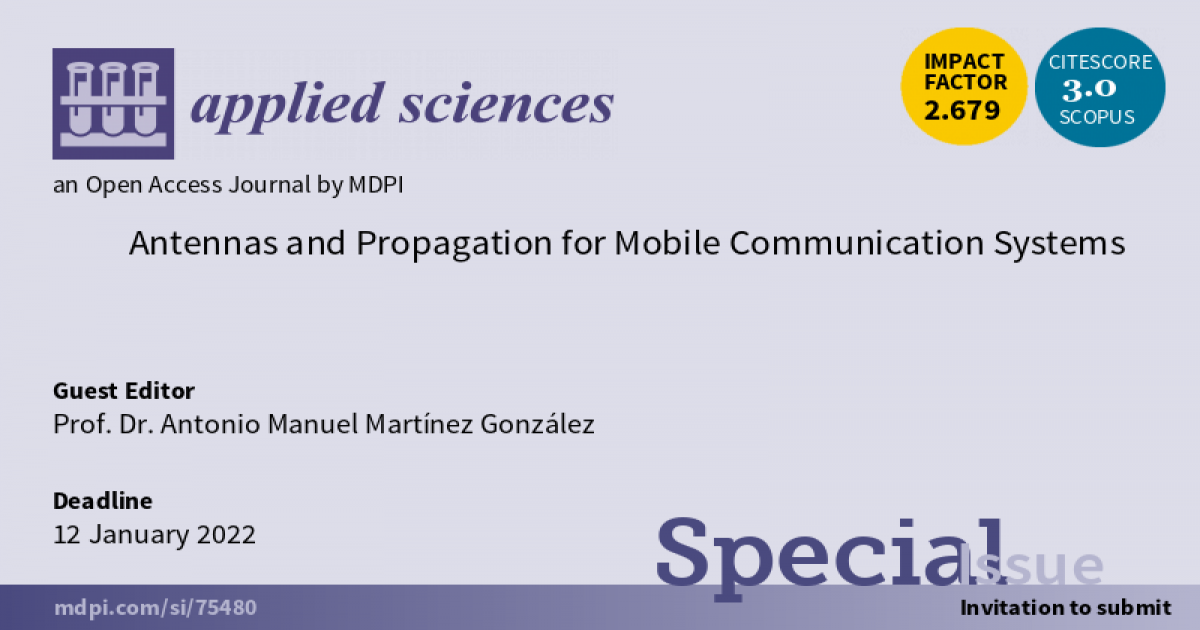Antennas and Propagation for Mobile Communication Systems
A special issue of Applied Sciences (ISSN 2076-3417). This special issue belongs to the section "Electrical, Electronics and Communications Engineering".
Deadline for manuscript submissions: closed (12 January 2022) | Viewed by 6020

Special Issue Editor
Special Issue Information
Dear Colleagues,
The imminent emergence of 5G technology in mobile communications systems is posing a new demanding challenge in antenna design that must take into account the particularities of both the different propagation channels and the physical space available in the terminal for the antennas. In fact, design priorities always attend to commercial aspects that make it more attractive rather than to the space needs for the antenna, which in turn must respond to an increasingly demanding compatibility of standards: Bluetooth, Wi-Fi, 4G/5G, GPS.
The antennas used in this technology can be classified into outdoor antennas such as fixed-base stations, indoor antennas with omnidirectional coverage, and small low-profile antennas for mobile devices. The increase in mobile data traffic given in this next 5G generation will lead to the improvement of techniques already known or the implementation of new ones such as the use of multibeam antennas, which means an increase in coverage. Likewise, miniaturization techniques, group optimization, MIMO systems, bandwidth improvements, among others, acquire great importance. In the future, 6G will have a wider frequency band, higher transmission rate, improved spectrum efficiency, greater connection capacity, shorter delay, wider coverage, and stronger anti-interference capability to satisfy various network requirements.
This Special Issue aims to collect relevant papers describing the latest advances and prospects in antenna design for mobile communications. You are cordially invited to submit a contribution of either an original research or a review article to this Special Issue.
Prof. Dr. Antonio Manuel Martínez González
Guest Editor
Manuscript Submission Information
Manuscripts should be submitted online at www.mdpi.com by registering and logging in to this website. Once you are registered, click here to go to the submission form. Manuscripts can be submitted until the deadline. All submissions that pass pre-check are peer-reviewed. Accepted papers will be published continuously in the journal (as soon as accepted) and will be listed together on the special issue website. Research articles, review articles as well as short communications are invited. For planned papers, a title and short abstract (about 100 words) can be sent to the Editorial Office for announcement on this website.
Submitted manuscripts should not have been published previously, nor be under consideration for publication elsewhere (except conference proceedings papers). All manuscripts are thoroughly refereed through a single-blind peer-review process. A guide for authors and other relevant information for submission of manuscripts is available on the Instructions for Authors page. Applied Sciences is an international peer-reviewed open access semimonthly journal published by MDPI.
Please visit the Instructions for Authors page before submitting a manuscript. The Article Processing Charge (APC) for publication in this open access journal is 2400 CHF (Swiss Francs). Submitted papers should be well formatted and use good English. Authors may use MDPI's English editing service prior to publication or during author revisions.
Keywords
- mobile communications
- antenna design
- radioelectric propagation
- 4G/5G
- MIMO systems
- chanel characterization
- reverberation chamber
- beamforming
- base station
- measurements techniques
- electromagnetic compatibility
- regulatory issues
- EMF exposure
- multi-beam antenna technologies
- distributed antenna systems
Benefits of Publishing in a Special Issue
- Ease of navigation: Grouping papers by topic helps scholars navigate broad scope journals more efficiently.
- Greater discoverability: Special Issues support the reach and impact of scientific research. Articles in Special Issues are more discoverable and cited more frequently.
- Expansion of research network: Special Issues facilitate connections among authors, fostering scientific collaborations.
- External promotion: Articles in Special Issues are often promoted through the journal's social media, increasing their visibility.
- Reprint: MDPI Books provides the opportunity to republish successful Special Issues in book format, both online and in print.
Further information on MDPI's Special Issue policies can be found here.





